Willow is considered one of the oldest trees on the planet. Siberia and Middle Asia are venerated by Fatherland willows, and the opposition is growing in the USA. The tree is wider and more beautiful in pivnіchnyh and pomirnyh latitudes, although it grows differently in subtropical areas.
The tree has a lot of variety. Below are the most common and the most common willows:
Files for allergens: low, so that the number rises even a small file in the window. Point your mouse at the image to make it more respectful. Joy for rosemary: willow, why cry, leaves tree, you can cut off the bribe, if she has spent all her leaves, and її cut the shortness more often, but it’s easy to finish it, lower it’s rare, but it’s true. Don't forget to come in later.
Vikoristannya: Gnuchka, ale stick wood vikoristovuetsya for the preparation of rackets and boxes for cricket. White willow bark avenges glucoside, called salicin, which has analgesic, anti-rheumatic and anti-rheumatic powers: it is supplemented with alcohol, this principle is diluted with salicylic alcohol, which is oxidized to remove salicylic acid, as it is found in the drug aspirin.
- rod-like;
- purple;
- goat;
- weeping;
- kulasta;
- dwarf;
- p'yatitichinkova;
- american;
- praiseworthy;
- Russian;
- gostrolista.
Now about the leather tree in order.
willow
This type of willow is considered to be one of the widest. Є chagarnik with bezlіchchu gіlok, which reaches uphill close to 5 meters. The bark has a purple color with a grayish tinge. Nirki brown color. Earrings rozkrivayutsya practical nіvnі z leaves. Growth in medium smoothie edge.
Leafing through that nirki to revenge the calm principle. white leaf verbi vikoristovuvavsya mandrіvniki as a bait for fishing hizhakіv. Leaf of white willow, attachments to lead hook, reacts in water, yak fish, food for meat fish. From May onwards 300 sightings from the cold and calm regions of Pivnichnoi pivkul. Willows can be leafed leaves, which are cherguetsya, for a wink of some kind of vistas of staunch leaves. In the spring, see the deacons clamor for us with their great cocoons.
Often reaches 25 m-code and is heard everywhere in France, de vin є common. Yogo is often carried out at the button head, suvorim that with regular rosemaries of yoga head, to make a bunch on the top of the trunk. Shovkove pubescence gives white-gray leaves under it and є decorative interest to the tree. The crown is wide, narrow, with straight needles fresh tickets, covered with needles, which have grown, sirimi behind the color, on a direct stovburi, whose brush crackles too early.
For planting, it is better to choose stalk until frost grows, so that the stench does not freeze. To that, before laying the fence, the varto was designated as a territory. It is necessary to dig a hole with a diameter of 50 centimeters and such a depth. If the soil is rough, varto add to the new sand. Plant next with an interval of 20 centimeters. After planting, the roslin should be watered frequently.
"Limbde", the human variety "Calvi", straight, even more energetic, that is why it wins for windy swarthy swags and performances of "Syritseya", silver willow, with shovkovist leaves from both sides, silvery-syrim. Even accepting a small variety. "Tristis", was a willow, weeping, a female clone, a rounded port, gleaming yellow and dull, not reaching the ground. Smaller, lower type "Vitelina", buttocks egg yolk vzimku, often grown for wattle.
Verby, to cry, can reach 10-12 meters and the mother’s large screen cracked the bark. Leaves are plainly smooth, long and frailly zagostrene. Heads, disproportionately long and elastic, pale green on the back, yellowish green, turn brown in age. Willow Marshall is suitable for France and can be 10 m or more. Vіn stіyky to the climate and the soil and can withstand a dry dry mind.
purple
In purple willow, the leaves are planted on black and opposite dove, up to 12 cm. Most often, this kind of trees can be grown in the middle and middle regions, and in the mountainous Urals and Crimea. You can also speak in America, Asia and Africa. The tree is light-loving, but it is unfriendly to endure the soil waters and the flooded log cabins. Vіd measles clean well. Appreciate tim, scho malogіllyasta.
To supplement the yield of dense hybrids, willow-marso created a variety that weeps: "Pendula". Another right tree among the root willows, a tendent willow occupies an area that stretches to Asia. Vin is so energetic himself, ale less tall, lower was the willow. Yogo top is wide and round. Yogo trunk can reach 6 m on the stake. The filaments are brown-red to olive-yellow, naked and gleaming, lamayutsya white of the base, saving at the same time the wickerwork of the wattle for their dozhina. As we leaf, we’ll make it look like the stink of pubescence, light-black-green under it and light-green.
It does not matter to choose a place for planting purple willow: it is necessary to choose a place with constant access to light. Tse tree to love zlozhennya, that happen to acquire automatic watering grass. Tsya willow grows in the sight of other times, because it does not vibrate to the ground. sadity varto early spring.

Krykhka willow is sensitive to the wind. Vzimku we know from the species-looking vitonchen harbor, a wide crown, which is made up of vertical olive-yellow trees. Beijing willow is similar to white willow, but less energy, you want to grow quickly. Yogo leaf, fresh green and bright, may blakitnuvatі vіdobrazhennya below.
The stench is formed early, and it lingers on the tree for a thriving hour. Black willow with a height of up to 12 m is native to Pivnіchnoy America. Yogo arched port, chastkovo vіd yogo razgaluzhenih gorki. Juveniles are yellowish, slightly pubescent and tendentious. Yogo leaves are pale green, and measles is a rough dark brown color.
Kozyach
Goat willow is a universal species for landscaping. Grows up to 10 meters of curl. May smooth green-gray bark. Gіlki roslini schіlnі i rozlogі. Leaves an oval shape with notches from the green surface of the beast and the light gray fluffy bottom. Such a tree grows in the European part of the country and Asia Minor. The place of residence is to serve as a non-swampy soil or a lisovі galyavin.
In the natural state, the laurel willow can grow up to 18 m and is isolated, it develops a wide and low dome. Scandinavian adventures are also spontaneous in our mountains. Vin often turns into a buttonhole and that secure weave. good quality. The color on the cob of the listing shows the color of the golden-yellow color. Filigree olive green to yellow. Leaves with a resinous smell should be broad, bright green and nagad laurels.
Tse duzhe decorative chagarnik from spring to autumn through the yogo leaf: erysipelas color, and the stench was embellished with white or cream marks. Yak i yogo pіdvorot, vіn vіmagaє vologogo, fresh grunt. For example, in the winter, in the spring, grow the rosemary kuli: leave less than 10 cm in the villota of the ridges of the front rock. Rosemary is necessary to save the harn kul. Ale the same rozmir lie in the aesthetics of yoga colors. True, the price of new pagons, as they represent the most beautiful gradations of erysipelas white tickets yaki give the whole decorative aspect.
In the steppe zone, you can see an order of forest valleys.
Saditi goat willow shorter than before, if there are optimal minds in it, so call before the month and collect the root mass. The tree on the back of the head needs to be watered frequently. On dry land, it's more likely to robiti more often. On another river, the growth of її can be watered once a day.
weeping
Weeping willow growing up great roses. The bark has a yellow color. Leaves of green vіdtinku. The pins are lowered down. The place of residence of this tree is to serve as a water reservoir in the middle smelter of Russia.
Verby, like a great open space, light and guilty but planted in isolation. For their adventures, they give precedence to the edges of the waters, zagalom, waters of the foundation. May all the willows will germinate so kindly that it’s easy to trim them in bunches or bugs, roblyats regularly pierce the skin 2 rocks.
Verby is also easy to control. When circumcised, on the cob of winter, take 25 cm long bollards, 2 cm bark of the base, to take root development, and press the sum of the sand and fill the soil close to 10 cm in the opening, crushing in the garden; mulch 10 cm and water clear, after the bitter frost, hung over the leaves. Plant the live spring of the coming autumn in the last quarter of the city.
Plant given to the roslin, next to the soil, and fertilize with compost. Z zhivtsіv tree growth shvidshe. Plant a weeping willow in the best way in autumn. Pagoni need to choose you, like not less than two fates. The living quarters are due to growth in a home greenhouse, and when spring comes, it is necessary to transplant them to a plot, de-dig holes of singing roses, approximately 50 centimeters. The soil should be passed through and fertilized. Do not forget to water the roslin often and keep an eye on it.
The willow, which weeps, is native to China and arrives to Europe across the shovkovo road near the descent, which is to come, and is a leafy tree, which is characterized by rapid growth and short lives. It can reach heights from ten to twenty-five. Tse roslina, as it is respected by the sacred goddesses of all mothers, and in ancient times, in Greece, the tree of the moon goddesses was loved. Through those who spend their fruits early, wine has become a symbol of sensibility, recognized as an absolute value. roselin, tied with nostalgia and melancholy through the form of low hair, which makes you think about the sum.
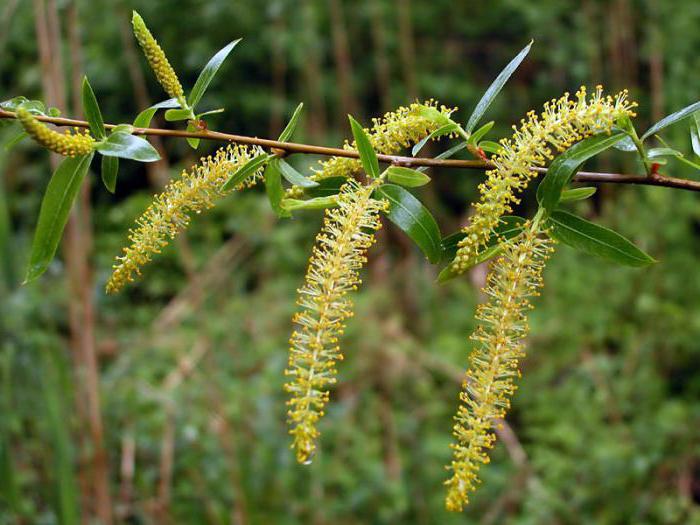
Kulyasta
The bushy willow grows up to 20 meters and may be faceless massive trees. Vzimku leaves tsієї roslina zminyuє svіy green colors to olive. Roslina is tied to vology, that rowing helps to save it. Stay cold. The leaves are of a flattened form and trochs are short. Sob the willow was left with a bush, її next often trim. Grow up kulasta willow it is practical in all areas of the country, but you can try to find it in Australia, Africa and America. Sack the tree up to 80 years.
Even thin and pendulum grommets give you a characteristic look. Leaves may light-green colors and vuzku shape and dozhina, as it can reach 15 cm at dozhina. The fields are serrated on the needles, ruffled in a spiral with a top, embossed to the ground like this. The lower side is lined with a clear, characteristic fluff. In the autumn, the stench swells a yellowish color before the fall. Flowers of roselin are hung and grouped at the earring. For some willows, it's exclusive women's quarters, and in others - less than people. The fruits are folded from the right capsules, which is a small amount of time, and the skin may have a bunch of fluffy white hair.
Plant її varto at the kvіtnі. Sadzhantsi ring out to bathe at the rose. When planting a willow tree, they dig a pit with a depth of 30 centimeters and lower the saplings there with fertile soil near peat that looks good. Tse allow the growth of virosity mіtsnim and healthy. Golovne, do not forget to regularly water the gardens.
Karlikova
Dwarf willow can be richly varied in the whole world. Growing up in Europe, and in America. Zustrichaєtsya and in gіrskih areas. The tree is resistant to cold weather, not tolerant of sintering. Therefore, the temperature of 25 degrees Celsius will be comfortable weather for the mind of the life of the dwarf willow. Leafing at tsієї roslini drіbne and do not have any particular problems when picking. The main advantage of such a mini-view is that the crowns of the tree can reach from a meter to two.
In order to be written, it is necessary to spread yoga in sony areas and to characterize pivtin. Like planting in dark and permanently shaded areas, wines may tend to grow less quickly and mothers are more prominent at the rosette. Wines are better suited to low temperatures and more-less severe frosts navit yakscho stink long hour. For the virility of the strong and the rich lively speeches. Wines flourish in wetlands and swampy areas, where the water is constantly stagnant.
When planting willows, plant the soil in the preparation of mineral fertilizers. On dry land, it is necessary to water the growth more often. It is especially not viable until cold weather and can grow in puddle soils.
At the same time, breeders are effectively engaged in the breeding of new dwarf varieties willows, and vvazhayut, scho future behind them.

They often hang around the edges of stakes or piece stakes. The ideal hour for planting willows is spring. The whole tree, as if afraid of drought and lack of luck, let it lead to a singing death. The stench does not require a particularly frequent or regular circumcision, but for a pure aesthetic factor, the stink can be short-lived or short-lived, not zavdayuchi shkodi. Tim is not less, they need to be flooded like a half hour of growth, so periodically with a frequency of two or three rocks on the cob of autumn, or even less often in the last winter before the vegetative restart.
Organic goodness can be added to the ground at high vіdsotkah. In such a rank, not only the earth is adorned, but the roslin is provided with all life-giving speeches, which are necessary for a healthy and strong one. The willow, which weeps, may be more dense than the growth, may be a tenditnu tree, and often thin hilts are easily broken.
P'yatitichinka willow
P'yatichinkova willow, the description of which will be presented below, shows itself well in the weave. Virostaє on onions and peat bogs near Siberia, as well as in European patches of the edge, zocrema near the lowlands. You can still see at the Far Skhodі that in the Ural mountains. The tree syagaє zavvishki over 10 meters. The bark of the roslin is brown in color, and the pagons, the leaves of the nibi, shine at the sleepy exchanges. The willow leaves themselves make up a leaf of laurel, looming an oval shape with denticles along the edges. The upper part has a leaf of green color, and at the bottom - pale-dull. Basically, wood is used for wicker furniture.
Ailments, yakі most afraid - tse іrzha that cancer. The most widespread parasites, like attacking the yogo stalk, are rodile or caterpillars, against which it is necessary to get in the way, the first stink will bring the growth to death. You can carry out special treatments with anti-cryptogamic products, like steaming on the growths, in order to protect the spread of ailments, which caused the death of the growths.
Floating willow avenges high levels of salicylic acid, the front of the classic aspirin, which can also be anti-bolic, anti-rheumatic, antipyretic and anti-seizure. You can beat the vines, crushed from the leaves, for the relief of rheumatism, fever, calm down abscesses and relieve ailments caused by the most wide-spread ailments. With the bark you can prepare a vіdmіnі vіvannya, korisnі like lowering the temperature, and for the shortest treat of diarrhoea.
When planting awnings, it is necessary to fill the ground with peat and compost and plant live plants in the hole. Call to plant on a clay of up to forty centimeters between rows of a fringe of fifty centimeters. For whom we will pierce the ground with a shear, and in the world, where the willow grows, we will lower the growth. Let's improve the soil. Livestock planted vertically and from pivnich on pivnich. This method is practiced by gardeners.
In addition, start with the bark, you can make baths for them with the same ones to change the drinking of them. Often traditions, zvichas and zvicha suspіlstva, as if they were not given out in due order, better for everything, will be spent and underestimated. In other situations, it is better for us to get along without something, for that which we do not have time to read, for that “suspenstvo” and people change, as well as for real consumption.
In the midst of the rural tradition of wines “mayzhe”, having adopted the technique of ligature with willow, it was so richly victorious in the past ten years in viticulture. Earlier it was victorious, because there were few alternatives. For our ancestors, there was little time to dedicate the whole operation.
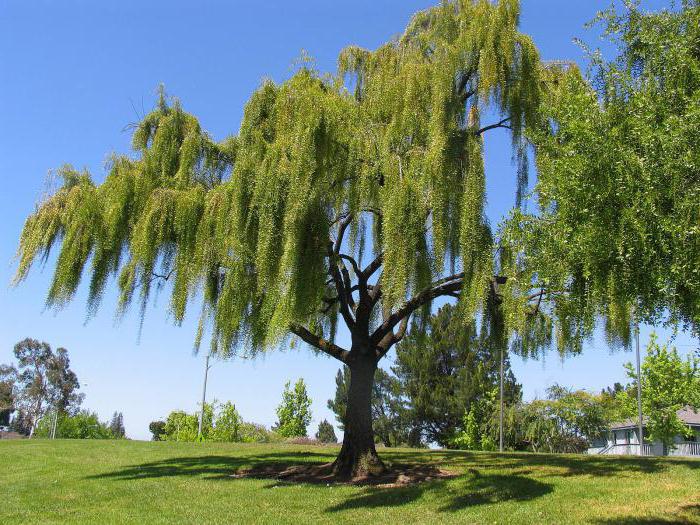
american willow
American willow is being cultivated in the leafy regions of Russia. Vaughn is a hybrid of purple and five-eyed willow.
After the end of the growing season, the heels do not straighten to the bottom. Leafing through the vuzka that is lower up to 15 centimeters. At autumn period the bark may have a purple tint with a different degree of intensification. Below is a vine of green color. Plus, it grows in the fact that it saves universal capacity for virobiv from willow. Widely spread in the European regions of Russia.
However, it is most widely vicorated at Friuli Venezia Giulia, however, the red willow, as it is more pliable and universal, allowing it to be chipped, at that hour, as at Veneto, it is more beautiful to vicorate the willow. Sow our willows, or Vench'yar near Friuli is left by the water close to the month of their stubble. After a month, you can wink in a negligent way; reshta can safely rumble by the water until quiet feasts, until the stink will not be beaten. In the past, winter, on cold and rainy days, mature growths were cut, and chicks, tied to a bunch, were delivered to the farm.
Such a rose, like an American willow, next to plant in the grass. Livestock is lowered vertically at the hole with a depth of 30 centimeters and from pivnich day on pivnich i amplify the earth. Here, like at the five-pointed willow, a metal shear is lowered into the ground. This method is practiced by gardeners.
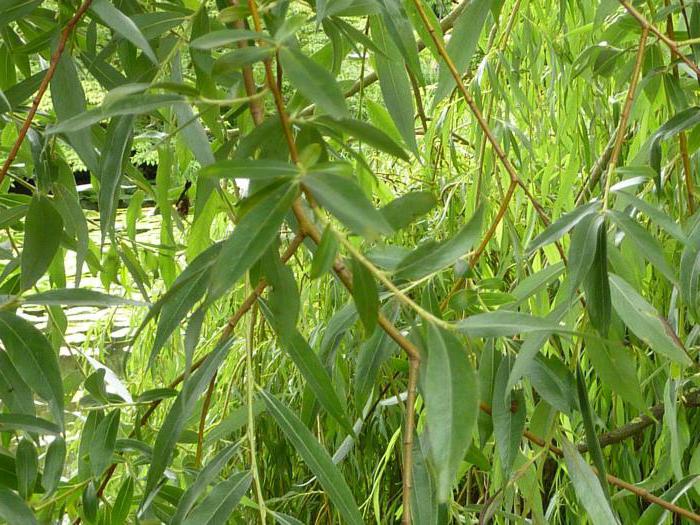
Willow
Willow-leaved є sumіshshu prutovidnoї and p'yatichinkovoy. Virostaє like a bush zavvishki mayzhe 5 meters. Pagoni tsієї roslini thin and gnuchki brown color. The leaves are lanceolate, and there are notches along the edges. The dressing of the sheet may have a loose shape.
Juvenile leaves are lowered on top, and older ones are bare and slightly feathered down. Practically zavzhdy give a single rod of troch more than 2 meters at the dovzhin, shading the soil, and by doing so, we will fight against the undergrowth. The springiness of the rod is the same as that of the five-eyed willow. It is wonderful to be cleansed with measles. The place of residence of such a tree, like a willow willow, is found in the coastal zone in the middle region of the country, as well as in Europe.
To plant a willow tree, you need soil, de є loam. The place can be arranged in such a way, where you need a sleepy light. In the darkness, the tree is not viroste. You can also vikoristovuvati the place, where you know the soil water.
To properly plant tsyu roslina, it is necessary to follow the following rules:
- dig a hole with a diameter of 50 centimeters and a depth of 30-40 centimeters;
- at the bottom of the pits, pile sand and rubble;
- nasipati dobriva from peat and soil;
- dig a hole in the third with earth and put a sadzhanets there;
- tamp the soil at the sight of the pit, to make it easier to water.
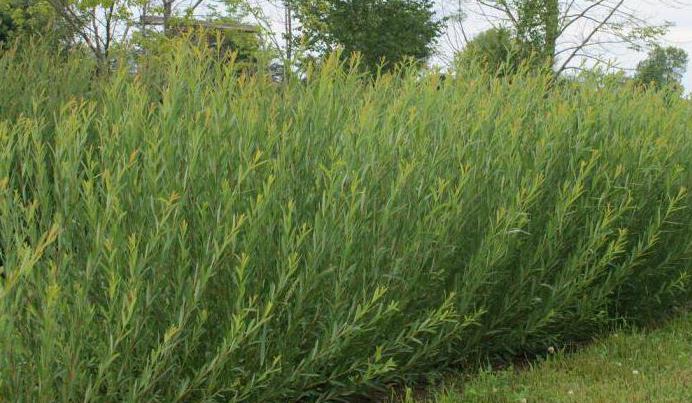
Russian willow
Russian willow is considered less adventitious for weaving. The whole tree reaches a maximum height of 10 meters, and the chaffarium grows up to 6 meters of the crown. Hilki podovzhenі, kolіr syro-greens. Leafing in the shape of a vuzka lanceolate. Roslin is the most prosperous in the Skhidniy Sibir and the Far Descent. You can see the rivers and lakes, and also the beaches. The rod of low strength and softness is mainly vicorated in naked looking without measles.
Qiu roslin should be planted at the herb. The living creatures are lowered at the hole with a depth of 30 centimeters and the earth is deepened. Like a p'yatichinkovoy willow and an American one in the soil, lower the metal shear. Zhivtsi hang vertically and from the pivden immediately to the pivnіchny zahіd. This method is practiced by gardeners.
gostrolista willow
From the gostral leaf willow, it’s not enough to shy away. Roslina itself reaches about 10 meters of crown, and bushes grow up to 5 meters. Maє vydovzhenі thin pagony dark brown vіdtinku. The shape of the leaf is pointed, and there are denticles along the edges, to the beast - with a glare, and at the bottom - from a greenish tint. The European region of the country is recognized as a place for the expansion of such growth, and in Siberia and Central Asia it grows more slowly.
This tree can be planted near the coastal areas, de vono make dense chagars. Stay until frost and dry. The willows of our country are expanding most of the time.
The rods of such a tree, like astrolists, willow willows for weaving of various furniture, krim koshikiv.
When planting a willow tree, it is necessary to prepare a planter, swiping from outside objects. We will need to excavate grooves with a diameter of 30 centimeters and a depth of 40 centimeters. After whom, plant saplings, sipping the soil with mineral fertilizers. Do not forget to water the willow, especially during the dry season.
Miraculous tree, wider than our countryside - tse willow. It’s over the top of the garn itself: a tight stovbur, thin drooping hilts, thinner lower leaves of different shades of green, quilts near looking fluffy earrings. Mabut, the leather bagger of the pivnіchnoї pіvkuli is well aware of the willow, and the rich who grow it on their garden plots.
Among the people, willow is called willow, grafted, willow, vine, willow, willow, sheluga, moreover, it is called fallow in the form of honey.
The tree has long served as inspiration for poets, writers and artists. Iomu was dedicated to his ranks by A. Fet, S. Yesenin, A. Akhmatova, F. Tyutchev and a lot of other poets, and G. Kh. The most famous painting, which depicts this tree, is the “Weeping Willow” by K. Monet, vtim, a tree can be planted in rich landscapes.
Willow is seen at home and among rich religions. In Christianity, willow replaces palm trees in Palm week. In Judaism, the tree played the role of one of the symbols of Holy Sukkot. It is from Chinese mythology that a little gleam with a soft willow, which wails demons, is held in the hands of the merciful goddess Guanyin. Willow trees are often seen in folklore. The Japanese legend says that there, in the growth of the rakita, the primar settles, and the Englishmen vvazhayut the willow with evil growth, as if they were following the mandrivniki.
An unseen tree in the house is not only mystical, but rather mundane, practical authorities. Iva is widely victorious in medicine, craftsmanship and virobnitstv, and the agricultural state.
- Medicine. Leaves and bark willows rejoiced at feverishness in Ancient Egypt and Greece, and Native Americans victoriously celebrated rokity as sickly. In the past years, in different parts of the growth, a low brown coloration was revealed: tannin, salidroside, salicin, flavonoids. And widely seen salicylic acid, with the help of which they began to prepare aspirin, first they discovered it themselves from the willow.
- Virobnitstvo. Thin gnuchki groves from ancient times were vicorated by the inhabitants of the pivnіchnoi pіvkulі for wicker furniture, pastes for ribeye, fences and parkanіv. Vine weaving has gone to our days. At the same time, from willow vines, cats, stilts, caskets, and colics are most often prepared. Wattled objects are superbly beautiful and miraculously fit into rich interior styles. The willow tree is also suitable for weaving paper, skeins and fabrics, and the ecological fashion of the remaining rocks revived the interest in natural willows.
- Silske gospodarstvo that dovkilla. The weeping tree is widely vicorous for the strong state. Firstly, willow is a miracle honey plant, especially valuable for its early blooms. In another way, the leaves of that leaf are suitable for thin food. The rokitnik often hangs over the bridle of the coast, which they support, otherwise they schiliv yariv. Zavdyaki old roots that call, roslina copes with erosion. The vitality and resilience of a tree sometimes become an environmental problem, for example, in Australia, willows were widely vicorated for the strengthening of the shores, planting majestic vineyards with it. The willow took root well and sprung up like a rich roslin. In addition, the tree is stagnant for cleaning waste water, shaping of desiccated foxes, draining swampy plots
- Gardening and landscape design. Willow, and especially її deyakі varieties that you see - a wonderful decorative culture, it’s good to embellish a house. Before that, the tree was superbly unsightly and slender in growth. Many famous designers include willow in their compositions, creating gardens in a romantic style.
Botanists classify the willow (lat. Salix) to the willow family (lat. Saliceae). Next to the village, there are growths and chagars, which can be deciduous or, richer, evergreen. Representatives of the willows are different: some of them are great trees with a tight stovbur that reach 40 meters in height, others are dwarf chagars that spread. Starry look deliberations by the district of growth. High vidoes grow in the calm and subtropical blends of Europe, Asia and America, and dwarf willows grow more importantly in the beer.
Most often, the willow has a large weeping crown, which is formed from a large number of drooping gilling stems, covered with bark of various shades: from light green to dark purple. The bark of young pagons and stovbura sound smooth, with age it begins to crack. Leafing, for a rare wine, roztashovane spirally and sit on a short petiole with two leaflets. The Їx form is more varied: most of the time, they are striated with linear and vuzcolanceolate leaves, the trochs are narrower - with elliptical and rounded ones. The edge of the sheet handkerchief sings of embellishments with small or large cloves, wanting to clearly see with smooth edges.
The willow is a two-house roslina with ancient human and female flowers, picked from the thick bunch of earrings. The willow-trees are opened in the spring, before the leaves appear; When the flowers ripen the plaid at the sight of the box great kіlkistyu a dry smell with a thick white forelock. Now to be carried by the wind on the great vіdstanі i, having drank by the water or a mule, for a long time takes care of its similarity.
Decorative vidi, hybrids and willow varieties
There are no less than 550 species of various willows in the family. Such diversity is the result of natural mutations and activity. For a long time, a lot of hybrids were bred. Navit botanists often worry about the classification of the other kind, but what can we say about simple gardeners-amateurs.
And yet you can see a sprinkling of views, which are most often planted, parks, squares and garden plots attached to landscaping.
Willow bіla chi srіlyasta(lat. Salix alba) - a large (up to 30 m high) tree with a thick bark that crackles, and a wide openwork crown. Roslina is widely spread in Russia and many allied republics, as well as in Western Europe, China and Asia Minor. It grows more importantly on the banks of rivers and other waters and often occupies majestic areas. Even nevibagly that quick growth in sympathetic minds; Dovgovichna (some copies reach 100 and more years), endure good and lack, and too much vology, unviable to the ground. Vіdmіnno podkhodit for landscaping the great ones, including mіsk territorіy, can vikoristovuvatysya for otrimannya vines.
Vіdmіnі risi vіd mind - thin drooping gіlki, pofarbovanі in sіryasto-syriy, vіdtinok vіdtinok pagonіv change to stormy. The bright green smooth leaves have a lanceolate shape and a friable pilus edge; Round flowers-earrings develop on a hinge, one hour from the leaves.
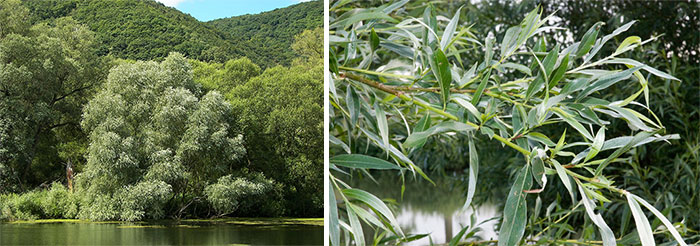 I. bila
I. bila A wide zastosuvannya culture zoomed in on the emergence of different forms, different varieties and cultivars.
Deyakі raznovidi:
- Zhovta (var. vitellina) - a large rounded crown and golden yellow or red pagons.
- Bliskucha (var. Sericea) - a medium-sized tree with thin, emerald-gray leaves.
- Siza (var. caerulea) - gіlki straightened up under a small kutom, black-gray leaves.
- Srіblyasta (f. argentea) - young leaves may garni, srіblyasto-syriy v_dtinok from two sides, pіznіshe front side the leaf becomes thick-green, the back is covered with gray.
- Zhovta weeping (f. vitellina pendula) - even thin and long pagons that fall to the ground.
- Oval (f. ovalis) - leaves of an unusual elliptical shape.
Among the great number of varieties of white willow can be seen like this:
- Golden Ness (Golden Miss) - a variety that has been taken off in the city of the Royal Garden Association. Roslina is especially addictive to wintering, if the thinned gold-yellow needles are exposed.
- "Tristis" (Tristis) - willow willow with a classic look: a bunch of bright green leaves on thin drooping needles. Vіdrіznyaєtsya vysokoy morozostіykіstyu it is recommended for areas with cold winters.
- Yelverton (Yelverton) - a non-visible tree or a chagarnik with red-hot red-zhovtogoryachy pagons.
- "Aurea" (Aurea) - great roslin with invisible, yellow-green, leaves.
- "Hutchinson's Yellow" (Zhovtiy Hutchinson) - chagar, which reaches 5 m at height, embellishments with thin pagons of a red-yellow vіdtinku.
- "Britzensis" (Britzenska) - red-brown pagon.
- Chermesina Cardinalis
 I. "Golden Ness", I. "Yelverton", I. Aurea, I. "Chermesina Cardinalis"
I. "Golden Ness", I. "Yelverton", I. Aurea, I. "Chermesina Cardinalis" Willow Babylonian chi weeping(lat. Salix babylonica) - a tree, as if it were brittle with yellowish-green drooping needles. Widened near the subtropical zone - Central Asia, Chornomorsk uzberezhzhya caucasus, pivdenny uzberezhzhi Krim. After the name, the fatherland of culture is China, the stars were transported to other regions. At a height it reaches 12 m, the diameter of the crown is about 6 m. Even more decorative, the shards have a short leafless period: the leaves fall off less in the middle, and even like a fierce one, they grow up again. The Babylonian willow is especially black in early spring, if it is covered with fresh young greenery.
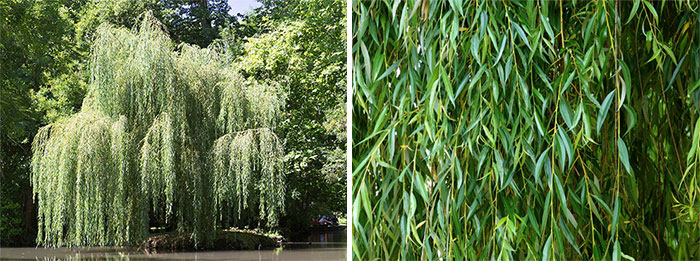 I. Babylonian
I. Babylonian Unfortunately, the species is not frost-resistant and cannot grow in regions with cold winters. The culture does not have any other special advantages: it does not require special soils and it is easy to put up with short periods of dryness.
Three different types are widely seen one:
- Pekinskaya (var. pekinensis) - widened more importantly in China, Korea and Northern Siberia. Also in the house under the im'yam willow Matsudi (lat. Salix matsudana).
Sortіv weeping willow more than that:
- "Tortuosa" (Tortuosa) - roslina is strongly bent, as if bi-twisted, with brown-green needles and brightly fresh leaves.
- "Crispa" (Crispa) - in this variety, it is not the pagons that are twisted, but the leaves, as if making cunning coachmen on the needles.
- "Tortuosa Aurea" (Tortuosa Aurea) - curved red-yellow stems.
 I. Tortuosa, I. Crispa, I. "Tortuosa Aurea"
I. Tortuosa, I. Crispa, I. "Tortuosa Aurea" willow purple(lat. Salix purpurea) - roslina, popularly called yakoї - zhovtoznik. This species is ubiquitous in the pomor belt of the pivnichnoy pivkul. It is a middle-high (in the middle 3 m, maximum width - 5 m) leafy chagar with dense purple or yellow pagons, straight uphill. Move, bright green to the beast and silvery green salutary side, The leaves are folded in pairs, and not black, like in other species. Succulents, which are dangling, turned into a purple color, stars and the name of the taxon. Purple willow is often vicorated for basket weaving, decorative gardening- Like a living creature.
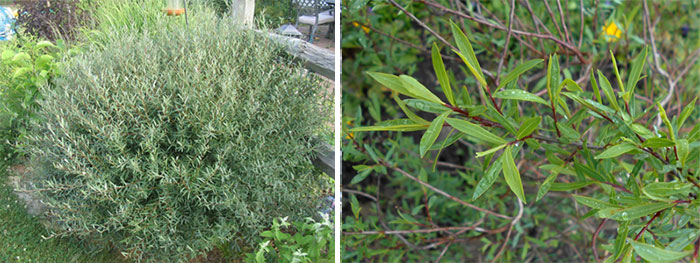 I. purple
I. purple The most popular forms:
- Vitonchena (f. gracilis) - chagarnik, which is fast growing, with lower gray leaves.
- Hanging (f. pendula) - chagarnik with a wide crown, covered with thin pagons, hanging down, of purple color.
- Dwarf (f. nana) - dwarfed by compact roses and a neat stump crown.
The middle varieties can be seen like this:
- "Norbury" (Norbury) - a low-growing variety.
- "Goldstones" (Zoloti kamenі) - a beautiful golden flower.
- "Irette" (Іrett) - low chagar with narrow grey-green leaves.
Willow goat(Latin Salix caprea) among the people is often called a beacon or a willow. The official name is due to the fact that it grew by goats and vines. Wild specimens often grow in the pomirny belt of Europe and Russia, as well as near Siberia and on the Far Descent. On the vіdmіnu vіd іnshih vіvіv volіє slititsіtsya in dry places, prote, as there is no such possibility, it can grow along the banks of the waters or in the swamps.
This is a large tree (up to 13 m at height) or a chagarnik with wide tight needles and oval bright-green leaves. Behind the shape of the leaves one can see other species of willow and nagadu, swidshe, wild cherry. Succulent catkins appear in early spring, even before the leaves appear, and in the grass they ripen numerically.
 I. goat
I. goat Roslin is widely victorious in medicine, the agricultural state, everyday life and crafts. At the same time, the number of low decorative forms and varieties was taken away, the main planting of these - landscaping of various territories:
- "Kilmarnock" (Kіlmanrok) - a low chagar with long drooping needles, greenish oval leaves and yellow or gray flowers.
- "Weeping Sally" (Sally, weeping) - a variety similar to the front one, but more compact varieties.
- "Silberglanz" (Silver Gloss) - lower leaves with a bright sheen on the surface.
- "Gold Leaf" (Golden Leaf) - leaves of this variety, on the other hand, may have a golden look.
(lat. Salix integra) is a similar Asian species, which is most common in Japan, China and Korea. Looks modest (no more than 3 m of the veil) in size and compact form. Deyak botanists vvazhayut roselina with a variety of willow purple. Looks rosy. chervonim or zhovtimi. needles and narrow leaves with practically open petioles.
Often zustrіchaetsya yak decorative crops the standard form is especially wide. The most popular variety is "Hakuro-nishiki" (Hakuro nishiki) or "Nishiki Flamingo" (Nishiki Flamingo) with compact roses and beautiful variegated cream, erysipelas and green leaves. These varieties often pinch more frost-resistant goat willow and grow in the middle smooth without covering.
 I. whole leaf "Hakuro-nishiki"
I. whole leaf "Hakuro-nishiki" Willow Lamka(Lat. Salix fragilis) - a native species for Russia, widely spread in Europe and Western Asia. Roslina was brought to Pivnіchnu America and to Australia, de changed into a Buryan, you can see the victories.
It is a large (up to 20 m) deciduous tree with a trivial life. Rozlog krone is folded from thin needles, which are easily broken with thick crackling (stars and the name of the species). Broken twigs that have fallen near the water are easily rooted, and if the leaks are carried far away, they establish new colonies. On the pagons, bright green leaves are rotting under the surface.
 I. lamp
I. lamp In culture, there is a sprinkling of different varieties:
- Puhirchasta (var. bullata) - a beautiful crown with soft, rounded humps, which looks like a giant broccoli.
- Basfordiana (var. basfordiana) is a hybrid of yellow-orange needles.
- Russelliana (var. russelliana) is a high-growing variety species.
- Chervona (var. furcata) - a dwarf willow with scarlet red branches.
Decorative varieties:
- "Rouge Ardennais" (Chervony Ardennes) - effective reddish-orange needles.
- "Bouton Aigu" (Thin bud) - pagoni of olive-green to purple color.
- "Belgium Red" (Belgian Chervoniy) - burgundy pagon and emerald-green leaves.
Willow(Latin Salix viminalis) sing vicorist for the selection of vines, ale and decorative forms. This is a tall (up to 10 m) chagarnik or a tree, which is seen as long-lived pagons, which is wooded with a century. Juvenile chicks are covered with a short, shiny pile, which you know from time to time. Dzhe vuzke chergovy leaves appear at the kvіtnі, one hour from golden-yellow blossoms.
Gostroleaf willow(lat. Salix acutifolia), also called red willow, growth in the greater part of Russia. The whole deciduous tree is abo chagarnik, the boundary height of which is 12 m. Awakened by thin, long pagons of brown or reddish color and narrow two-coloured leaves: bright green beast, grayish-shrinking from below. Roslina is especially beautiful on the front, if fluffy earrings are opened, moreover, it is worn even before the leaves appear. Biggest domestic variety- "Blue Streak" (Blakitna smuga) is seen with thinned black-green leaves.
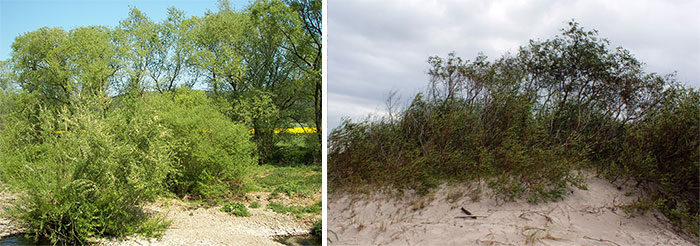 I. rod-like, I. gostrolista
I. rod-like, I. gostrolista Willow sang(Latin Salix repens) - an arch of thinning undersized (no more than 1 m) species, widening in France. In other regions, it grows more rarely and less like a cultivar. Main authority - large number razgaluzhenih stalks, as if on the back of the head we cover with harmata, and then they become bare. The leaves are oval-elliptical in shape and have different surfaces: pubescent gray underside and glossy dark green beast. The fluffy blossoms are roaming around the garden. Roslin is buried in rich regions of France.
The most popular species - willow smelt of silver (var. argentea) - high price decorative roslina with densely pubescent gray leaves and purple pagons.
Volohat or woolly willow(Lat. Salix lanata) - subarctic species, similar to growth in Iceland, Pivnichny Scandinavia, pivnichny sunset in Russia. Let's grow a low-growing (not more than 1 m) chagar with densely streaked pagons. Young pagons are covered with short bluish garmata, with a year the stems turn brown and smooth. Cicava leafing out of sight - silvery color, oval-ovoid shape. The texture of the sheet is oxamite, povstyan. The view is miraculously suitable for landscaping the farms near the pivnіchny regions.
Verba spisopodіbna(Lat. Salix hastata) - Another low-growing chagarnikovy species, the average height of which is 1.5 m, and the boundary roses are no more than 4 m. Wild specimens often grow in Pivnichny Europe and America, Far Going, Siberia, Central Asia. Roslina is seen as flattened pagons that grow uphill or spread on the ground, as well as oval leaves, smooth animals and slightly pubescent from the turning side.
Willow(lat. Salix reticulata) - low-growing decorative roslin native to the North of Siberia and the Far Descent. In nature, food for deer. The whole gilliast low (up to 0.7 m) chagarnik, embellishments with glyasty succumbing stems and inconspicuous leaves. Leaves of an oval shape and a dark green vіdt_nka mayyutnu texture shovkovistu surface. Zavdyaki to the thinned look, the willow is often planted near the design of parks, public gardens and home gardens of the pivnichny regions.
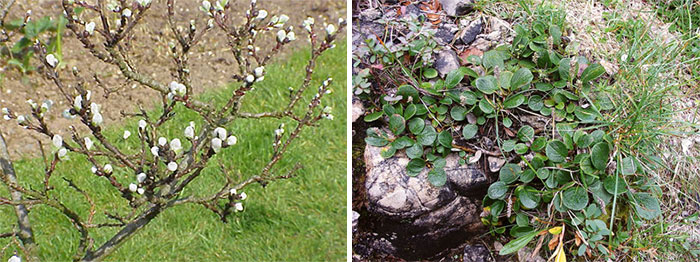 I. list-like, I. current hour
I. list-like, I. current hour Willow in landscape design
Raznomanіtnіst vіdіv rokiti allows you to choose roslin, which is suitable for specific minds. Nasampered, it is necessary to focus on the expansion of that place of expansion of the deli.
On the wide expanses of the great square there will be ancient trees - silver willow, goat willow, willow in the calm climate, Babylonian willow on the pivdni. High cultivars are supposed to be used for planting greenery in Moscow parks and public gardens, instilling a healthy dewy smog on roads. The building of overgrown trees is more visible up to a swedish growth, dimo- and gas-resistance make them indispensable for planting in the areas of Novobudov.
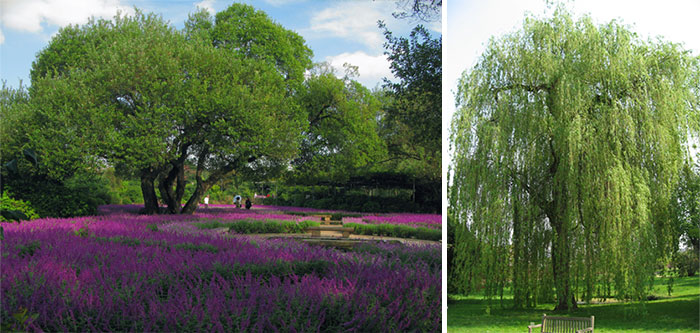
Willow, especially water-loving varieties, is indispensable for decorating that beautiful shore in different water bodies. It will take root well in the middle of the Vologda. The only problem is that the bagatorichnik grows quickly, occupying the countryside. The next step is to control the growth: scrupulously kill the young shoots.
Middle-growth varieties of willow - purple, full-leaved - hang out like tapeworms on open galyavins or galyavins. The stench is the center of the landscape composition, which is how the lower cultures grow. Another option for planting similar willows is the organization of living creatures.
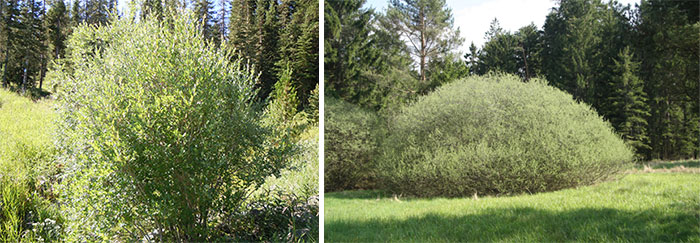
Compact vidi that variety (pozucha, sіtchasta, volohata, spisopodіbna) can be planted on modest plots beyond the size of the world; Such willows look badly like the lower or middle tier of a varied landscape composition, which is made up of chagarnikovy bagatorichi. In addition, the willow grew stunted miraculously for the design of the banks of miniature country waters: strumkiv and stavkiv. In this manner, it is an original imitation of river landscapes.
Viroshchuvannya that sight
Grow the willow on your own garden dilyantsi clumsy: the tree is more unviable and does not look like a folding sight. However, different views of the willows are often not similar one to one and require different minds: soil, amount of water and lighting. Retailing can be done and the method of reproducing roslin. The very first task of the gardener is to determine the type of willow and fallow in the face of the day.
Roztashuvannya, soil, pіzhivlennya, watering
May all the roslini be vvazhayutsya light-loving. The stench is easily streaked straight sleeping room and give priority to open spaces, vtim, a small shade does not harm a tree. You can hang a willow like in the open sun, and in pivtin.
The water content of the plot is to lie in the chosen mind. The greater number of willows in nature are more important than ever to settle on the banks of water bodies, so they should be placed closer to the water.
[!] For the help of the strained root, the willow has grown up, like a great amount of water. The power of the vicor tree is for draining swampy soils and land plots with near-surface deposits of groundwater.
The willow is not strong enough to store the soil, but it wants to overcome the fluffy (water- and povіtro-permeable) and revitalizing substrate, so that a sufficient amount of sand and loam can be avenged. Peaty grounty, in which the vologa stagnates, the tree does not love and only deyaki willows (white and purple) buildings grow on peat bogs.
In the coming years, watering will be required only by young non-malignant specimens. Nadalі tree itself vydobuvaє nebhіdnu vologu for the help of the hard root system.
clipping
Iva vіdmіnno to endure decorative trimming, and the crown after the help of this procedure becomes thicker and more decorative.
Low- and medium-sized willows with bushes, straight uphill, can be molded near the stalks or parasols on the lower (stem), in drooping varieties of sleds, just shorten the lengths of the wood, which reach the surface of the earth. You can regulate the height of the tree, streaming this growth.
It is better to see the bushes in the early spring, before the start of the growing season, or in the fall. You can lightly trim a tree by stretching a long litter. Examples of pidlyagayut:
- pushing the leading pagons (there is a stream of tree growth and accepting the appearance of young beech pagons),
- zayva shoots on stovburi (like a willow is formed on a stem),
- needles that grow in the middle and thicken the crown.
If there are standard willows, then there are two main forms: a fountain and a sump. In order to take away the fountain on the lower-trunk, the frogs should run short of the troch along the edges, so that the dove allowed them to hang freely, satisfying the green likeness of water streams. The kulyasta form is more radical than a radical circumcision on the stake.
[!] When circumcised, pluck the outer brunka on the neck, straight up the hill. Nadali young vtecha on such a gіltsі is also growing correctly - uphill.
Like an old tall willow growing in your garden, which it respects to other cultures and borrows a significant part of the land - do not indulge in it, but form a pretty green sack to lie on the ground. Just trim the stovbur close to the ground. In this rank, the stovbur stop growing uphill, and from the yogo lower part, young pagons will appear without a hitch, yakі you will be able to grow up to a baguette figure.

Stovburi of young willows often twist or bend down to the ground. In order to correct, it is necessary to move the trunk to the support, for example, a metal pipe dug into the ground and remove it for 2-3 rocks. For the whole hour, the trunk is guilty of straightening and filling with a bagan shape.
Reproduction of that willow tree
In the wild nature, willows multiply on us, live bait, you can see it - wind it with twigs. In culture, the tree is the most lively, the shards of the earth are very similar to the world and it is good to save only by the water or the mules.
Living creatures for hanging are guilty of growing from not too old and not too young. The stench is not to blame, but it’s not to be tovstim, or on the other hand, thin - and ti, and іnshi are unlikely to give a root. The optimal length of the live bait is about 25 cm.
Visajuvat livestock for rooting is possible in the end of the harvest, before frost or in the middle of spring. In pagons, leaves are seen in the lower part and built up near the soil under a small kut, in front of them you can soak them in the root, if you want to mow a tall one from this root.
If you hang a sprat of willows, then between them you can become at least 70 cm for low-growing species, 1-3 m - for medium-sized ones and 5-7 m - for tall trees.
Shkidniki and ailments
Willow є fodder growth for rich comakhs. The tree is attacked by over 100 species of popelets, beetles, larvae of various panicles, tree ants, and sometimes on willows sporadzhuyut their nests of the axis. Roslin has matured, and it is easy to see the attack of the coma, and the axis of young specimens can suffer greatly. In order to save the nemіtsnіlі willows, shkіdnіv slid to pick up with your hands, otherwise, as the colony has grown too much, to seek help from modern insecticides.
In the rural area, young willows often eat goats that graze. Tsikh creatures are not varto close to the entrance to the hanging trees. From grizunіv unsafe mice, scho smell the sap of the root of that green pagon.
The tree is attacked not only by shkidniki, but by various infections. One of the widest willow ailments is iris, which is called by the fungus Melampsora, the main symptoms of which are storms and orange patches on the leaves. Fungicides - antifungal preparations will help to fight against diseases.
